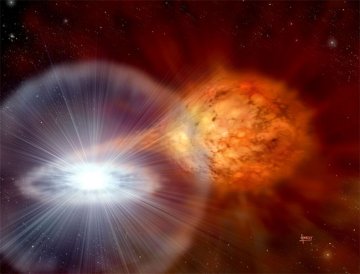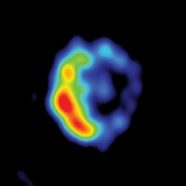Dead star exploding
Huge nuclear explosions have ripped the outer layers off a dense, nearby star.
By Emily Sohn
If the relaxing nature of stargazing makes you think that space is a peaceful place, think again. The galaxies are full of violent explosions that rip apart stars and hurl clouds of gas in all directions.
Scientists recently got their closest look yet at a type of star explosion called a nova. Their observations gave them a new way to think about the most powerful type of star explosion, called a supernova.
 | ||
|
| ||
| David A. Hardy/www.astroart.org & PPARC |
The observations focused on a system called RS Ophiuchi, which is actually a pair of stars 5,000 light-years from Earth. One star is a white dwarf, which on its own would have finished burning. It is small (about the size of Earth) and compact. Its companion star is a much bigger red giant that is nearing the end of its life and getting ready to explode.
The red giant produces a strong wind that blows matter onto the white dwarf. When enough stuff builds up on the white dwarf, a powerful explosion takes place on the smaller star’s surface. The result is a thermonuclear blast.
The last thermonuclear explosion in RS Ophiuchi occurred in 1985. This year on Feb. 12, Japanese astronomers reported that the star system had suddenly become much brighter. Lots of researchers quickly turned their telescopes in the system’s direction to see what was going on.
The explosion, scientists now report, created a shock wave that slammed into the red giant. The phenomenon looked a lot like what happens when a supernova spews matter from a dying star into space. Instead of happening over the usual thousands of years, however, this one happened over just a few months. Two weeks after the eruption, the radius of the blast was already greater than the distance between the sun and Saturn.
The explosion started out in the shape of a ring. Then, over the next few months, it stretched out into a cigar shape. This suggests that the explosion came off the white dwarf in the form of jets, say scientists from Liverpool John Moores University in Birkenhead, England.
 |
|
This image shows radio waves from the recent explosion of a nearby, two-star system. Red represents the brightest emission; blue the faintest. The two stars would be at the center of this blast wave but are invisible in this image.
|
| Tim O’Brien et al., NRAO, AUI, NSF |
There are two ways to explain this unusual event, scientists say. Either the explosion shot off jets of matter in opposite directions or somehow the gas surrounding the red giant shaped the ejected material.
Either way, this is a new phenomenon for astronomers to consider. And, once more matter builds up on the white dwarf, there may be another explosion in 20 years or so.—E. Sohn
Going Deeper:
Cowen, Ron. 2006. Recurrent eruption: Explosive stellar saga. Science News 170(July 22):54. Available at http://www.sciencenews.org/articles/20060722/fob8.asp .
You can learn more about the explosions on RS Ophiuchi at www.pparc.ac.uk/Nw/RSOph2.asp (Particle Physics and Astronomy Research Council).
Information about the variable star RS Ophiuchi is available en.wikipedia.org/wiki/RS_Ophiuchi (Wikipedia) and www.aavso.org/vstar/vsots/0500.shtml (American Association of Variable Star Observers).
Science Project Idea: To learn more about observing variable stars, go to www.aavso.org/observing/ (American Association of Variable Star Observers).







